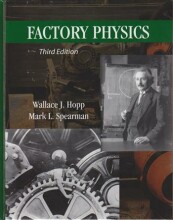Basic Factory Dynamics - Simple Relationships
11 important questions on Basic Factory Dynamics - Simple Relationships
Why does Little's law only hold in the long term?
In reality throughputs, WIP and CT's (cycle times) can change rather often as a result of variability (i.e. machine breakdowns, starving & blocking, etc.).
So if we look at these parameters in the short-term (i.e. we compare daily averages), they can vary widely.
However if we look at it in the long term (i.e. we compare yearly averages), these effects are evened out.
Consider a multi-machine line with 3 stations, running at the bottleneck rate.
Station 1 has 3 machines, with a processing time of 4 hours per machine.
Station 2 has 4 machines, with a processing time of 5 hours per machine.
Station 3 has 8 machines, with a processing time of 10 hours per machine.
What is the expected WIP at the stations?
Rb = 0,75 jobs per hour
WIP = TH x CT:
Station 1: WIP = 0,75 x 4 hours = 3 jobs
Station 2: 3,75 jobs
Station 3: 7,5 jobs
For penny fab two, what is CTbest when WIP = 10?
W0 = 8, so WIP > W0. Then CTbest = WIP/Rb = 10/0,4 = 25 hours.
- Higher grades + faster learning
- Never study anything twice
- 100% sure, 100% understanding
Can the worst-case scenario happen for a real-life system where jobs are moved individually and automatically after they are finished at a certain machine?
It generally cannot happen in real life unless products are moved in batches (and the opposite is stated in the question). So no.
There is however 1 very unrealistic case under the assumption in the question that could happen. This is when all machines in a line would break down just as the first job would arrive and when it would just be repaired in time when the last job has just arrived. (Exactly the same behavior as full batch moves.)
Can penny fab two exhibit PWC-behavior? Can penny fab one?
Penny fab one:
No, although the line is balanced & consists of single-machine stations, there is no randomness in process times (they are deterministic).
Penny fab two:
No, the line is not balanced plus it doesn't have single machines.
Can penny fab one exhibit best case behavior? Can penny fab two?
Can penny fab one exhibit worst case behavior? Can penny fab two?
Yes to all. It was even illustrated by using these examples.
Furthermore the same conditions apply for best and worst case scenario's, so any system that can exhibit best case behavior can exhibit worst case behavior and vice versa.
How can you improve performance in lines?
1: Add capacity at stations (either balancing or 'unbalancing').
2: Use parallel machines instead of single machines at stations.
3: Reduce variability of processing times (or batch sizes).
In figure 7.12 & 7.13 we can see the 3 scenarios.
An altered version of penny fab 2 (PF2) is shown (PF2 with exponential process times), but what line would represent the original penny fab one (PF1)?
This depends on the variability!
If the variability is at a maximum, PF1 will follow the worst case lines.
If there is no variability, PF1 will follow the best case lines.
If there is some kind of randomness introduced, PF1 will be somewhere in the 'bad' or 'good' region.
Under which three assumptions was the Practical Worst Case derived?
1. Balanced line
2. Single-machine stations
3. Exponential (memoryless*) processing times.
*This means that if the processing time on a machine is exponentially distributed, then knowledge of how long a part has been in process offers no information about when it will be finished.
How does internal benchmarking work?
- data on avg. WIP, CT & TH is collected (or at least 2 out of 3)
- the PWC, best case & worst case scenarios are calculated
- results are plotted and compared, actions can be taken
De cycle time for a Practical Worst-Case Performance (CTpwc) is given by:
What will happen in case:
1. w =1
2. w goes to infinity
1. The cycle time becomes the raw process time T0
2.The throughput will approach the capacity Rb, while cycle time increases without bound.
The question on the page originate from the summary of the following study material:
- A unique study and practice tool
- Never study anything twice again
- Get the grades you hope for
- 100% sure, 100% understanding
































